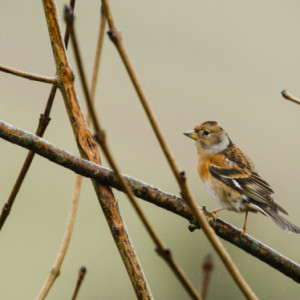Turnstone
As an avid viewer of BBC Winterwatch, you’ll of course have identified this on sight (episode 1 from 14m 50s, if you didn’t see the segment); and you’ll have remembered that it’s a visitor to the UK, and not a full-time resident. Having said that, turnstones can be seen around the coast of Britain for much of the year: birds that breed in Canada and Greenland come in the autumn for their winter holibobs, moult, and stay till spring; and birds that breed in Northern Europe sometimes turn up in the UK in late summer, on their way south to winter in Africa.
You’ll also have remembered that it’s a busy, tough and determined little bird, not especially shy of humans, and that it’s a prize scavenger, with one of the broadest diets of any bird, eating everything from shellfish and insects, through chips and other waste discarded by people, to animal and (one hopes very rarely) human flesh. Essentially, whatever the turnstone can digest, it will eat, which must be helpful given that it lives a migratory life and breeds in some pretty inhospitable places. They’ve been recorded as reaching 15 or even 20 years of age.
A few weeks ago I mentioned that a chap in a bird hide at Upton Warren had been advising me on good birding sites in Wales - which is why I drove to Aberystwyth after my lovely afternoon at Gigrin Farm yesterday, and how I came to sitting happily on the beach this morning, photographing a couple of dozen turnstones as they noodled around, dodging the advancing tide and looking for food. I was sad to have arrived too late yesterday to have caught the famous starling murmuration - though I did hear the noise of thousands of birds chatting to each other in their roost under the pier, as I walked around the town to stretch out the driving kinks before going for dinner. I was also sad to have missed the purple sandpipers that my acquaintance told me could be found at Aberystwyth in the winter - but he did say that I’d need to pull my finger out and head west as soon as possible if I was to see them before they migrated, and I didn’t, so I’ve only myself to blame. I’ll just have to return to look for them next winter - and I’ll aim to catch the murmuration then too.
When I left Aberystwyth I headed towards home, but about eight miles out of town on the A44 I swung into Bwlch Nant yr Arian, which he’d also recommended that I should visit. (You’ll thank me for writing out the name if you ever decide to go: he pronounced it Nanty Erion, and couldn’t remember how it was spelled, and it took me quite a long time and some creative searching to track the place down on the web.) Nant yr Arian is another site where red kites are fed daily, and here you can see the spectacle for just the price of a £3 parking ticket. Mindful of many miles still to go, and many, many photo files to process when I got home, I wasn’t planning to stay for the kite feeding today, but just wanted to familiarise myself with the site; and by the time I’d drunk a cup of coffee out on the balcony of the visitor centre I’d already spotted siskins and bramblings flocking with some other finches at a bird feeder, and some goosanders down on the lake. Just then a mass of cloud rolled into the valley and it began to pelt with rain, but I’m reasonably waterproof so I walked the perimeter of the lake anyway, getting a few shots of the goosanders, and, on the way back to the car, the brambling I’ve added as today’s extra. By the time I was leaving Nant yr Arion there were about a dozen red kites circling the site in anticipation of their lunch, and as I drove towards Rhayader large numbers of them were converging on Gigrin Farm from all directions. I can’t pretend that I wasn’t tempted to join them!
This evening R and I went to see Stan & Ollie, which I can’t recommend too highly: funny, sad, and charming, we both absolutely loved it.
2019 birds:
89 Pied wagtail
90 Turnstone
91 Herring gull
92 Brambling


Comments
Sign in or get an account to comment.


